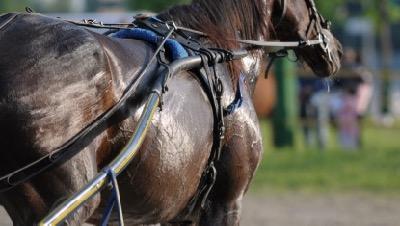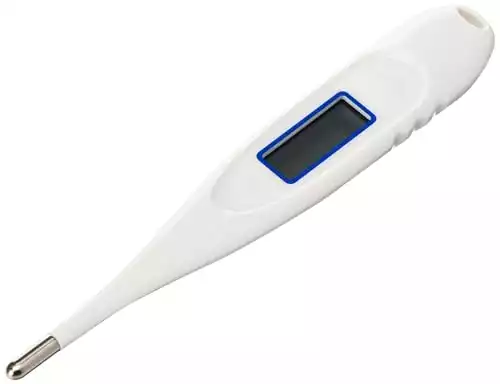Heat stroke in horses
How do horses thermoregulate in the summer? Can they get too hot? Yes, heat stroke is possible for horses. It’s a complex chain reaction that needs your vet’s attention. Many “logical” tricks may actually worsen the condition.
Jump to video and shopping
- Thermoregulation is the horse’s way of keeping his body’s core temperature at a normal and safe level. The horse also can bring his core body temperature back to normal. When it’s hot outside, this mechanism is critical!
Sweat is one way a horse thermoregulates – there are four other ways.
Thermoregulation in horses
A horse has several heat loss mechanisms, some of which are more effective than others. Convection, conduction, and direct radiation are sort of related.
- Convection is the movement of heat from your horse’s body into the air. Breezes will carry it away after it reaches the surface! It’s technically heat loss via the movement of air or water across your horse’s skin. Using a fan on your horse is one way to help convection happen.
- Conduction happens when the heat in your horse’s blood moves to the air. Conduction is a direct transfer of heat by actual touch. As a horse works and gets warmer, conduction will heat his saddle pad. It’s similar to a warm hand touching something cold to warm it up. Interestingly enough, water helps the heat from your horse escape much more rapidly than air, especially when the water is cold.
- Direct radiation is when a horse’s radiant heat comes off the horse, via infrared rays. It’s heat transfer without any physical contact. This usually happens when the temperature is lower than about 70°.
Other ways that horses thermoregulate
- Evaporative cooling by sweat! As your horse’s skin gets wet from sweat, it evaporates and takes heat with it. The more humid the weather is, the harder it is for evaporative cooling from sweat to do its job in cooling your horse. When exercise is intense, sweating can account for 85% of the heat lost.
- Your horse’s breath will help his thermoregulation, too. This is a small portion of how a horse thermoregulates, but it counts!

Don’t forget the lube – a water-based lube is just fine.
How you can help your horse and know what’s going on:
TPR checks.
- Making sure your horse’s temperature, pulse, and respirations are known at rest will help you monitor his responses. When heat and exercise come together, you need to know how high his vital signs are going, and how long it takes for them to return to normal.
- Normal vital signs for horses are:
Temperature – 99.5 to 101.5
For foals, up to 102 is normal.
Pulse (Heart Rate) – 24 to 40 beats per minute, although most horses are between 32 and 36.
For newborn foals, 80 to 100 is normal, and for older foals, 60 to 80 is normal.
Respiration – 8 to 12 breaths per minute
For foals, 60-80 breaths per minute
Appropriate work for his fitness levels and the weather.
- Nothing says potential disaster like pushing your horse past his fitness levels in the summer heat and humidity. Fitness is a marathon and not a sprint, so ramp up his exercise gradually. Perhaps a little bit every day is better than a lot for one day.
- His heart rate will give you an idea of his fitness levels, especially when you also track how his heart rate recovers after exercise. There’s more to learn about fitness levels here, and you can even listen to a podcast about this very topic here.
- Perhaps adjust how and when you are exercising. Summer months turn me into the earliest of early birds, getting to the barn at dawn. I beat the bugs, I beat the heat, and I can have the whole farm to myself. And, my horse doesn’t get stressed out from the heat and humidity. Tips for beating humidity can be found here.

I do not like this AT ALL.
- Be kind to your horse with lots of breaks when you are riding or exercising him.
- Allow him to walk so his heart rate and respiration can return to normal.
- Make sure he’s hydrated – by checking his gums – and let him have electrolytes before you ride.
FUN READ – read this to learn about when it’s too dang hot to ride your horse.
Have a cooling-off plan to avoid heat stroke in horses.
- Some great things to do for your horse include letting him walk a bit after the hard work is done. In summer months, untack him and hand walk in the shade. This allows the sweat under his tack to start evaporating and cooling.
- Use cool water to hose him off. This is especially helpful if he’s also a bit dirty or dusty, you’ll save some time in the grooming department by just washing it away.
- There’s some chatter about the whole “you must sweat scrape” and “you don’t need to sweat scrape”. Can I find this to share with you? Sure can’t. But here’s my thought – it’s probably quite safe to skip the sweat scrape. However, he’s going to take longer to dry, and he will definitely get muddier if he has a post-shower roll. He’s also going to drip, and many horses are offended by the mere thought of water dripping down a leg or off their belly. It may tickle. NOTE – these are also the same horses that volunteer to stand in the rain.
Fans and water help your horse cool!
- Use fans! Evaporative cooling from sweat and/or a shower is greatly enhanced with fans. There have been many a day when my horse’s sweat definitely could have used a rinse, but standing under the fan when I take off my boots and helmet and get organized leaves me with a horse I can easily just buff and groom.
- Monitor his TPR during the cooling off. A horse should have normal vital signs 30 minutes after exercise is finished. Some horses get really hot after they stop working, and their body temperature reflects that. The trend needs to be that the vitals normalize, not escalate.
- Let him drink! It’s 100% myth that a hot horse should not have water. If you have any concerns, your vet can help you come up with a plan.

What does heat stroke in horses look like?
- Hyperthermia is when your horse’s temperature rises due to a failure of his thermoregulatory systems. It’s commonly known as heat stroke, and it can be fatal.
Signs of hyperthermia in horses include:
- A temperature of 103° or higher. Please know that his temperature can go this high during exercise. The question becomes if he can recover and go back to normal.
- Respiratory rate of over 40 breaths per minute.
- A pulse of 80+ beats per minute that isn’t slowing down after a few minutes of rest.
- Your horse may sweat like he’s making a pond, or he may stop sweating all together.
Quick side note about sweat. An unfit horse or an obese horse is at greater risk of heat stroke, as is the horse with anhidrosis, which is the inability to sweat. Some horses have partial anhidrosis where they might sweat a bit, or only in certain spots on their bodies.
- Lethargy, fatigue, collapse, convulsions. Your horse may seem excessively tired during heat stroke, or things escalate to the point of collapse and seizures.
- If hyperthermia continues, the blood supply to his body becomes compromised and his muscles begin to shut down. His organs will also start to fail as the blood supply to his enormous digestive system and kidney’s is reduced. This can cause irreparable damage to these organs, even if he recovers. Lastly, his heart and brain are affected and can cause death.
When to call the vet:
- One sign that you MUST call the vet is when your horse has been sweating and his temp is up and then….he stops sweating. His life is in danger.
- If you find that he is showing signs of hyperthermia. Please call – it only takes a minute and your vet can give you directions as to how to reduce his body temperature.
What to do as you wait for the vet:
- Continue to monitor his vital signs. You can’t wait for your vet to arrive to start cooling him off. You have to help him.
- Move him into the shade and circulate the air around him if you can. Fans, open windows, and breezes can all help.
- Let him drink if your vet tells you to offer water.
- Apply ice to his major vessels. The neck, on both sides, and the vessels along the insides of the hind legs. The absolute easiest way to do this is to wrap ice packs around his neck and legs. If you have ice boots, use them. If you only have ice cubes, you can soak cloths or rags in icy water to sponge him off. Concentrate on the neck and legs, unless your vet tells you otherwise.
- Wet his body and use a fan to evaporate the water. Your vet may have you wet his body even without a fan.
My whole entire point of this is just this – knowing your horse’s normals can absolutely alert you when something is abnormal. Don’t wait it out, just call!

Stock up here for your horse supplies! As an Amazon Associate, I earn from qualifying purchases, but it’s ZERO extra cents to you. You can also visit my Amazon storefront here: PEG storefront.
Thank you!







